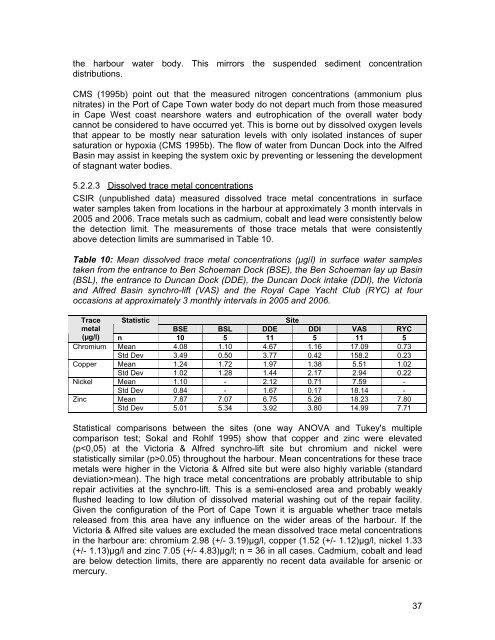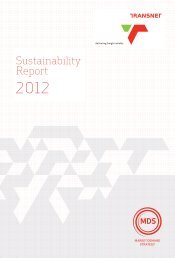BEN SCHOEMAN DOCK BERTH DEEPENING Specialist ... - Transnet
BEN SCHOEMAN DOCK BERTH DEEPENING Specialist ... - Transnet
BEN SCHOEMAN DOCK BERTH DEEPENING Specialist ... - Transnet
Create successful ePaper yourself
Turn your PDF publications into a flip-book with our unique Google optimized e-Paper software.
the harbour water body. This mirrors the suspended sediment concentration<br />
distributions.<br />
CMS (1995b) point out that the measured nitrogen concentrations (ammonium plus<br />
nitrates) in the Port of Cape Town water body do not depart much from those measured<br />
in Cape West coast nearshore waters and eutrophication of the overall water body<br />
cannot be considered to have occurred yet. This is borne out by dissolved oxygen levels<br />
that appear to be mostly near saturation levels with only isolated instances of super<br />
saturation or hypoxia (CMS 1995b). The flow of water from Duncan Dock into the Alfred<br />
Basin may assist in keeping the system oxic by preventing or lessening the development<br />
of stagnant water bodies.<br />
5.2.2.3 Dissolved trace metal concentrations<br />
CSIR (unpublished data) measured dissolved trace metal concentrations in surface<br />
water samples taken from locations in the harbour at approximately 3 month intervals in<br />
2005 and 2006. Trace metals such as cadmium, cobalt and lead were consistently below<br />
the detection limit. The measurements of those trace metals that were consistently<br />
above detection limits are summarised in Table 10.<br />
Table 10: Mean dissolved trace metal concentrations (µg/l) in surface water samples<br />
taken from the entrance to Ben Schoeman Dock (BSE), the Ben Schoeman lay up Basin<br />
(BSL), the entrance to Duncan Dock (DDE), the Duncan Dock intake (DDI), the Victoria<br />
and Alfred Basin synchro-lift (VAS) and the Royal Cape Yacht Club (RYC) at four<br />
occasions at approximately 3 monthly intervals in 2005 and 2006.<br />
Trace Statistic<br />
Site<br />
metal<br />
BSE BSL DDE DDI VAS RYC<br />
(µg/l) n 10 5 11 5 11 5<br />
Chromium Mean 4.08 1.10 4.67 1.16 17.09 0.73<br />
Std Dev 3.49 0.50 3.77 0.42 158.2 0.23<br />
Copper Mean 1.24 1.72 1.97 1.38 5.51 1.02<br />
Std Dev 1.02 1.28 1.44 2.17 2.94 0.22<br />
Nickel Mean 1.10 - 2.12 0.71 7.59 -<br />
Std Dev 0.84 - 1.67 0.17 18.14 -<br />
Zinc Mean 7.87 7.07 6.75 5.26 18.23 7.80<br />
Std Dev 5.01 5.34 3.92 3.80 14.99 7.71<br />
Statistical comparisons between the sites (one way ANOVA and Tukey's multiple<br />
comparison test; Sokal and Rohlf 1995) show that copper and zinc were elevated<br />
(p0.05) throughout the harbour. Mean concentrations for these trace<br />
metals were higher in the Victoria & Alfred site but were also highly variable (standard<br />
deviation>mean). The high trace metal concentrations are probably attributable to ship<br />
repair activities at the synchro-lift. This is a semi-enclosed area and probably weakly<br />
flushed leading to low dilution of dissolved material washing out of the repair facility.<br />
Given the configuration of the Port of Cape Town it is arguable whether trace metals<br />
released from this area have any influence on the wider areas of the harbour. If the<br />
Victoria & Alfred site values are excluded the mean dissolved trace metal concentrations<br />
in the harbour are: chromium 2.98 (+/- 3.19)µg/l, copper (1.52 (+/- 1.12)µg/l, nickel 1.33<br />
(+/- 1.13)µg/l and zinc 7.05 (+/- 4.83)µg/l; n = 36 in all cases. Cadmium, cobalt and lead<br />
are below detection limits, there are apparently no recent data available for arsenic or<br />
mercury.<br />
37

















